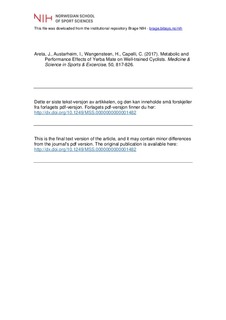| dc.contributor.author | Areta, José | |
| dc.contributor.author | Austarheim, Ingvild | |
| dc.contributor.author | Wangensteen, Helle | |
| dc.contributor.author | Capelli, Carlo | |
| dc.date.accessioned | 2018-11-06T12:37:53Z | |
| dc.date.available | 2018-11-06T12:37:53Z | |
| dc.date.created | 2017-11-17T13:13:53Z | |
| dc.date.issued | 2017 | |
| dc.identifier.citation | Medicine & Science in Sports & Exercise. 2017, 50, 817-826. | nb_NO |
| dc.identifier.issn | 0195-9131 | |
| dc.identifier.uri | http://hdl.handle.net/11250/2571245 | |
| dc.description | I Brage finner du siste tekst-versjon av artikkelen, og den kan inneholde ubetydelige forskjeller fra forlagets pdf-versjon. Forlagets pdf-versjon finner du på insights.ovid.com / In Brage you'll find the final text version of the article, and it may contain insignificant differences from the journal's pdf version. The definitive version is available at insights.ovid.com | nb_NO |
| dc.description.abstract | Introduction: Yerba Mate (YM) is a South-American plant, rich in polyphenols, saponins and xanthines, of growing scientific interest due to its metabolic effects. YM has been shown to increase fat utilization during exercise in untrained humans, but its effects on well-trained individuals during exercise are unknown. Methods: We characterized metabolic and physical performance effects of YM in eleven well-trained male cyclists. In a double-blind crossover design, participants ingested 5 g of YM or placebo (PL; maltodextrin) daily for 5 days, and 1 h prior to experimental trials. Results: Ergometer-based tests included a submaximal step-test (SST) at 30-80% of O2max (6 x 5 min stages), followed by a cycloergometer-based time-trial test to complete mechanical work (~30min, TT; n=9). Before and during tests, blood and respiratory gas samples were collected. YM increased resting plasma adrenaline concentration (P=0.002), and fat utilization by 23% at 30-50% O2max vs PL (Effect sizes Glass’ ∆ [ES]±95%CI, 0.8±0.55) correlating strongly with post-SST plasma [glycerol] (r=0.758). Treatment effects on rates of perceived exertion, heart rate and gross efficiency were unclear during SST. Respiratory exchange ratio during TT indicated carbohydrate-dependence and did not differ between treatments (PL, 0.95±0.03[SD]; YM, 0.95±0.02). TT performance showed a small (ES, 0.38±0.33) but significant (P=0.0278) improvement with YM (PL, 30.1±1.8[SD]; YM, 29.4±1.4 min; 2.2%±2[95%CI]) with average increase of 7W power-output (ES=0.2±0.19; P=0.0418; 2.3%±2[95%CI]) and 2.8% O2 (P=0.019). Pacing displayed lower power-output after 30% of total TT workload in PL vs YM. Conclusion: YM increased fat utilization during submaximal exercise and improved TT performance, but performance-enhancement effect was unrelated to measures of substrate metabolism during maximal exercise. | nb_NO |
| dc.language.iso | eng | nb_NO |
| dc.subject | ilex paraguariensis | nb_NO |
| dc.subject | cycling | nb_NO |
| dc.subject | endurance performance | nb_NO |
| dc.subject | ergogenic aids | nb_NO |
| dc.subject | metabolism | nb_NO |
| dc.title | Metabolic and performance effects of Yerba Mate on well-trained cyclists | nb_NO |
| dc.title.alternative | Metabolic and performance effects of Yerba Mate on well-trained cyclists | nb_NO |
| dc.type | Journal article | nb_NO |
| dc.type | Peer reviewed | nb_NO |
| dc.description.version | acceptedVersion | nb_NO |
| dc.source.pagenumber | 817-826 | nb_NO |
| dc.source.volume | 50 | nb_NO |
| dc.source.journal | Medicine & Science in Sports & Exercise | nb_NO |
| dc.source.issue | 4 | nb_NO |
| dc.identifier.doi | 10.1249/MSS.0000000000001482 | |
| dc.identifier.cristin | 1515308 | |
| dc.description.localcode | Seksjon for fysisk prestasjonsevne / Department of Physical Performance | nb_NO |
| cristin.unitcode | 150,31,0,0 | |
| cristin.unitname | Seksjon for fysisk prestasjonsevne | |
| cristin.ispublished | true | |
| cristin.fulltext | postprint | |
| cristin.qualitycode | 2 | |
